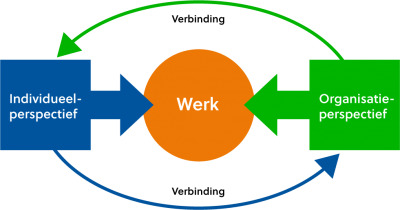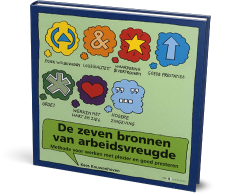
The mental legacy of Happiness at Work
Happiness at work can be used in many ways. Here is explained how it can be applied, what value it brings and what happens when it is applied.
The seven sources of happiness at work
Over a thousand people have taken part in my research into happiness at work. They have made two lists. The first filled with things from what they derive pleasure from in their work, what makes them thrive. The second list is filled with the parts where they get stuck and the parts which they do not enjoy. The answers form a clear pattern, we can clearly categorise them in seven sources. These sources are 'The seven sources of Happiness at Work'.
The language of the seven sources is suitable to put the individual perspective into words and to express the organisational perspective.
What can they do for you?
An increase in happiness at work positively affects the cooperation and the efficacy of employees.
Workplace assement
Create motivated people who feel heard and who feel like their contributing to the company.
Improving performance
Aligning the goals of the company and its employees.
Facilitate changing processes
Making sure all wanted changes are implemented and enforced in all places.
Teambuilding
Working together with joy and good performances.
Yearly feedback interviews that matter
Really having a good conversation instead off a tick box exercise.
Sustainable employability and vitality
Intrinsic motivation for concrete actions.
Reducing workload
Finding the bottleneck and making practical adjustments.
Strengthen motivation and loyalty
Mottivate people and create commitment to your organisation.
The principles
There are at least five principles which contribute to ‘working with pleasure and performing good’. All the trainings in Happiness at Work will stand by these five principles. While working with the seven sources of Happiness at Work, employees will start working more according to these principles.
1. Insight and focus on the desired future
 ‘Working with pleasure and performing good’ only exists when the path of the organizations aligns with the employees. They must be willing to. The things that are important to employees must be respected.
‘Working with pleasure and performing good’ only exists when the path of the organizations aligns with the employees. They must be willing to. The things that are important to employees must be respected.
2. Willingness to take responsibility
If you like something, hold on to it. If something does not please you, find out what it is exactly and tackle it. Having responsibility also has includes the organisational perspective: how are you going to contribute to the success of the organisation? Reversed, the management will also take responsibility for the individual perspective of its employees and their happiness at work.
3. Focus your actions on the real work
The first principles can only be achieved if they are turned into concrete actions. These actions should be focused of daily work. This is because happiness at work can mainly be achieved from daily work and less from occasional companies parties or such. Small steps of improvement in daily work can create a virtuous circle of happiness at work.
4. Focus on the power, the energy and the positive
This virtuous circle can be maintained if employees feel like they are free to do what they can do and want to do. The emphasis is put on what ís possible. We know how paralyzing the contrary from this can be, a culture of fear.
5. Mutual attraction
The organization makes itself attractive for valuable employees. Likewise, the employees make themselves attractive for organizations. Research into the 'value profit chain' shows that mutual attraction makes excellent (financial) performances.

Happiness at work To Enjoy Work and Perform Well
How do you align organisational and individual demands.

Why do the sources work?
In cooperation with the Free University in Amsterdam, I have conducted research into the seven sources of Happiness at Work. In this research it is showed how people with the sources are able to express their experiences much more accurate than people without the sources. When the question is asked ‘What do you derive pleasure from in your work?’, they will spontaneously answer the question with 3 to 4 of the seven sources. After being introduced with all seven sources, they all recognize these seven in their experience. Their vocabulary concerning happiness at work has doubled.
With this bigger vocabulary, people often discover more positive elements than they had expected. De negative elements, were often the ones they did know. Moreover, the sources do offer space for the negative sides of the work. They are not forcibly positive. In this way people are invited to share their entire perception.
The language of the seven sources is suitable to put the individual perspective into words and to express the organisational perspective. This way we have a ‘language’ available that is available for their personal experiences in work. They can talk more effectively about subjects like personal ambitions in work, workload and changes in work.
With this ‘language’ more positive elements are discovered in your work and it makes it easier to discuss these elements.
Do you want to get to work with Happiness at work?
Have you gotten enthusiastic and do you want to get to work? That is possible. You can independently practise the ideas after a training. Of course you can also contact our advisory desk.

Book: ‘The Seven sources of Happiness at Work’
This reading-, teaching- and workbook shows how happiness at work is attainable. A book full of practical help for discovering, expanding and attaining happiness at work: cases, interviews, quotes, models and checklists.






